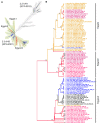Isolation of Genetically Diverse H5N8 Avian Influenza Viruses in Poultry in Egypt, 2019-2021
- PMID: 35891409
- PMCID: PMC9320977
- DOI: 10.3390/v14071431
Isolation of Genetically Diverse H5N8 Avian Influenza Viruses in Poultry in Egypt, 2019-2021
Abstract
The global spread of avian influenza virus (AIV) of clade 2.3.4.4b since 2016 has caused severe losses in wild birds and poultry and has posed a risk for the infection of mammals including humans. The vaccination of poultry has been used to limit the spread of the virus and mitigate its socioeconomic impact. Here, we describe H5N8 epidemics in chickens, turkeys and ducks from different localities in Egypt from 2019 to 2021. About 41.7% (n = 88/211) flocks were tested positive by RT-qPCR for H5N8 viruses with prevalence rates of 45.1% (n = 65/144) and 34.3% (n = 23/67) in vaccinated and non-vaccinated flocks, respectively. A sequence analysis of the hemagglutinin and neuraminidase genes indicated not only the multiple introduction events of H5N8 viruses in Egypt but also the establishment of endemic viruses in commercial poultry in 2020/2021. The recent H5N8 viruses in poultry in Egypt are genetically distinct from the majority of licensed vaccines used in the field. Together, our findings indicate that poultry in Egypt is an endemic center for clade 2.3.4.4b in the Middle East. The efficiency of current vaccines should be regularly evaluated and updated to fully protect poultry flocks in Egypt against H5N8 viruses.
Keywords: Egypt; H5N8; avian influenza virus; clade 2.3.4.4b; poultry; vaccination failure.
Conflict of interest statement
The authors declare no conflict of interest.
Figures




References
Publication types
MeSH terms
LinkOut - more resources
Full Text Sources
Medical

